Quality Management Assignment: Analyzing Factual Review Questions
VerifiedAdded on 2023/03/31
|5
|1275
|189
Homework Assignment
AI Summary
This assignment provides detailed solutions to factual review questions from a quality management textbook, specifically focusing on Chapters 6 and 7. The assignment addresses key concepts such as the definition of quality culture and its components, exploring how procedures and traditions influen...
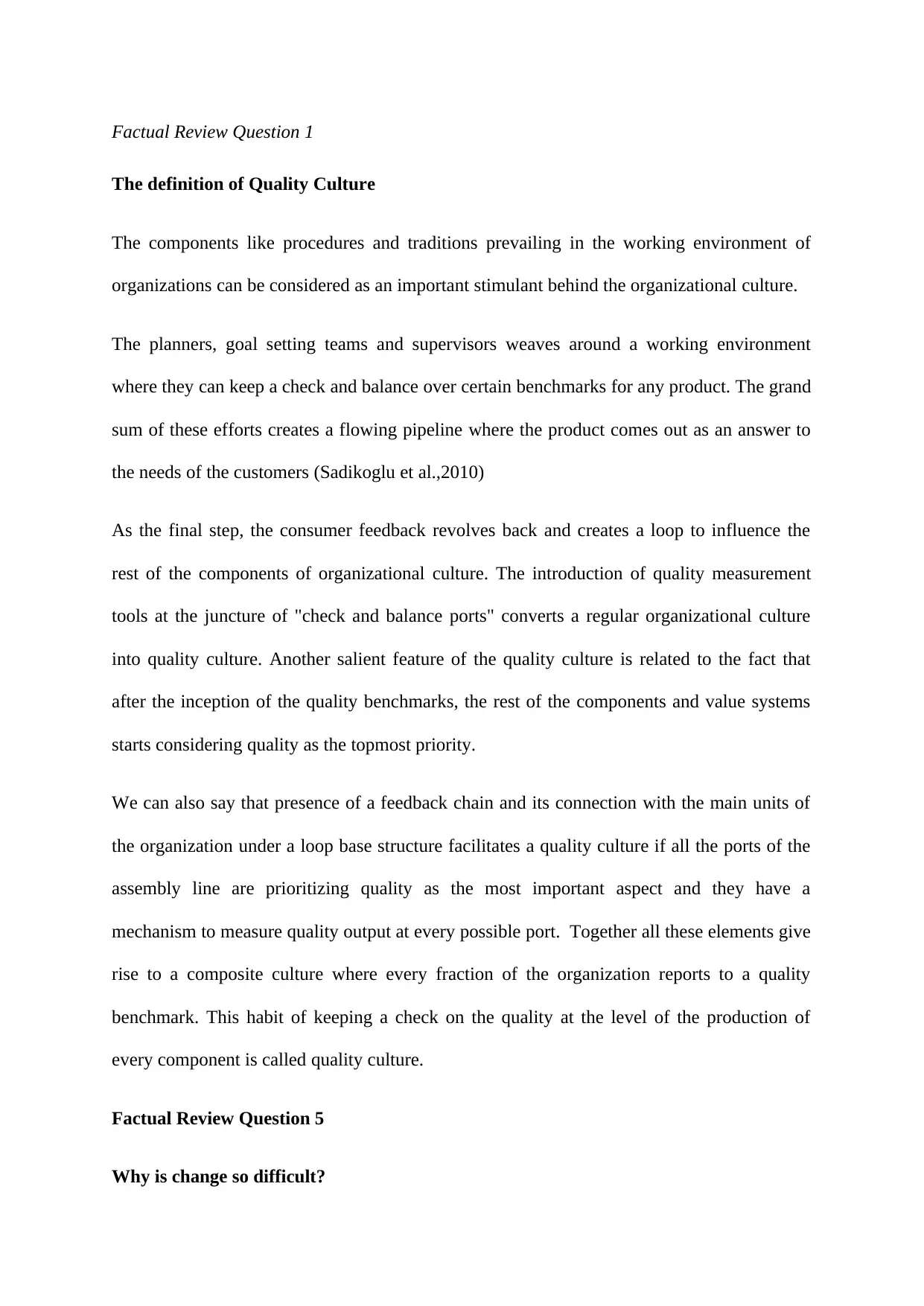
Factual Review Question 1
The definition of Quality Culture
The components like procedures and traditions prevailing in the working environment of
organizations can be considered as an important stimulant behind the organizational culture.
The planners, goal setting teams and supervisors weaves around a working environment
where they can keep a check and balance over certain benchmarks for any product. The grand
sum of these efforts creates a flowing pipeline where the product comes out as an answer to
the needs of the customers (Sadikoglu et al.,2010)
As the final step, the consumer feedback revolves back and creates a loop to influence the
rest of the components of organizational culture. The introduction of quality measurement
tools at the juncture of "check and balance ports" converts a regular organizational culture
into quality culture. Another salient feature of the quality culture is related to the fact that
after the inception of the quality benchmarks, the rest of the components and value systems
starts considering quality as the topmost priority.
We can also say that presence of a feedback chain and its connection with the main units of
the organization under a loop base structure facilitates a quality culture if all the ports of the
assembly line are prioritizing quality as the most important aspect and they have a
mechanism to measure quality output at every possible port. Together all these elements give
rise to a composite culture where every fraction of the organization reports to a quality
benchmark. This habit of keeping a check on the quality at the level of the production of
every component is called quality culture.
Factual Review Question 5
Why is change so difficult?
The definition of Quality Culture
The components like procedures and traditions prevailing in the working environment of
organizations can be considered as an important stimulant behind the organizational culture.
The planners, goal setting teams and supervisors weaves around a working environment
where they can keep a check and balance over certain benchmarks for any product. The grand
sum of these efforts creates a flowing pipeline where the product comes out as an answer to
the needs of the customers (Sadikoglu et al.,2010)
As the final step, the consumer feedback revolves back and creates a loop to influence the
rest of the components of organizational culture. The introduction of quality measurement
tools at the juncture of "check and balance ports" converts a regular organizational culture
into quality culture. Another salient feature of the quality culture is related to the fact that
after the inception of the quality benchmarks, the rest of the components and value systems
starts considering quality as the topmost priority.
We can also say that presence of a feedback chain and its connection with the main units of
the organization under a loop base structure facilitates a quality culture if all the ports of the
assembly line are prioritizing quality as the most important aspect and they have a
mechanism to measure quality output at every possible port. Together all these elements give
rise to a composite culture where every fraction of the organization reports to a quality
benchmark. This habit of keeping a check on the quality at the level of the production of
every component is called quality culture.
Factual Review Question 5
Why is change so difficult?
Paraphrase This Document
Need a fresh take? Get an instant paraphrase of this document with our AI Paraphraser
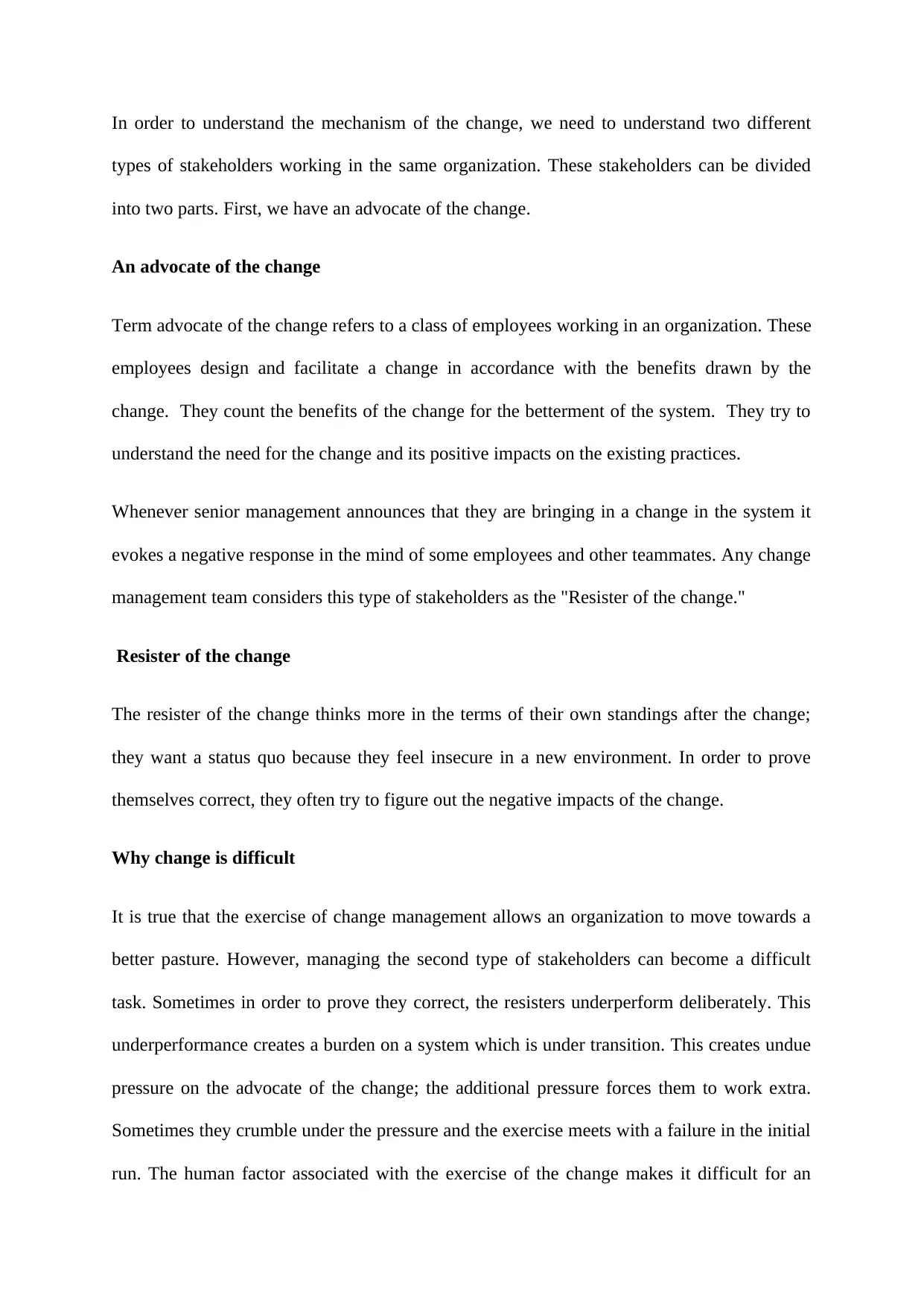
In order to understand the mechanism of the change, we need to understand two different
types of stakeholders working in the same organization. These stakeholders can be divided
into two parts. First, we have an advocate of the change.
An advocate of the change
Term advocate of the change refers to a class of employees working in an organization. These
employees design and facilitate a change in accordance with the benefits drawn by the
change. They count the benefits of the change for the betterment of the system. They try to
understand the need for the change and its positive impacts on the existing practices.
Whenever senior management announces that they are bringing in a change in the system it
evokes a negative response in the mind of some employees and other teammates. Any change
management team considers this type of stakeholders as the "Resister of the change."
Resister of the change
The resister of the change thinks more in the terms of their own standings after the change;
they want a status quo because they feel insecure in a new environment. In order to prove
themselves correct, they often try to figure out the negative impacts of the change.
Why change is difficult
It is true that the exercise of change management allows an organization to move towards a
better pasture. However, managing the second type of stakeholders can become a difficult
task. Sometimes in order to prove they correct, the resisters underperform deliberately. This
underperformance creates a burden on a system which is under transition. This creates undue
pressure on the advocate of the change; the additional pressure forces them to work extra.
Sometimes they crumble under the pressure and the exercise meets with a failure in the initial
run. The human factor associated with the exercise of the change makes it difficult for an
types of stakeholders working in the same organization. These stakeholders can be divided
into two parts. First, we have an advocate of the change.
An advocate of the change
Term advocate of the change refers to a class of employees working in an organization. These
employees design and facilitate a change in accordance with the benefits drawn by the
change. They count the benefits of the change for the betterment of the system. They try to
understand the need for the change and its positive impacts on the existing practices.
Whenever senior management announces that they are bringing in a change in the system it
evokes a negative response in the mind of some employees and other teammates. Any change
management team considers this type of stakeholders as the "Resister of the change."
Resister of the change
The resister of the change thinks more in the terms of their own standings after the change;
they want a status quo because they feel insecure in a new environment. In order to prove
themselves correct, they often try to figure out the negative impacts of the change.
Why change is difficult
It is true that the exercise of change management allows an organization to move towards a
better pasture. However, managing the second type of stakeholders can become a difficult
task. Sometimes in order to prove they correct, the resisters underperform deliberately. This
underperformance creates a burden on a system which is under transition. This creates undue
pressure on the advocate of the change; the additional pressure forces them to work extra.
Sometimes they crumble under the pressure and the exercise meets with a failure in the initial
run. The human factor associated with the exercise of the change makes it difficult for an
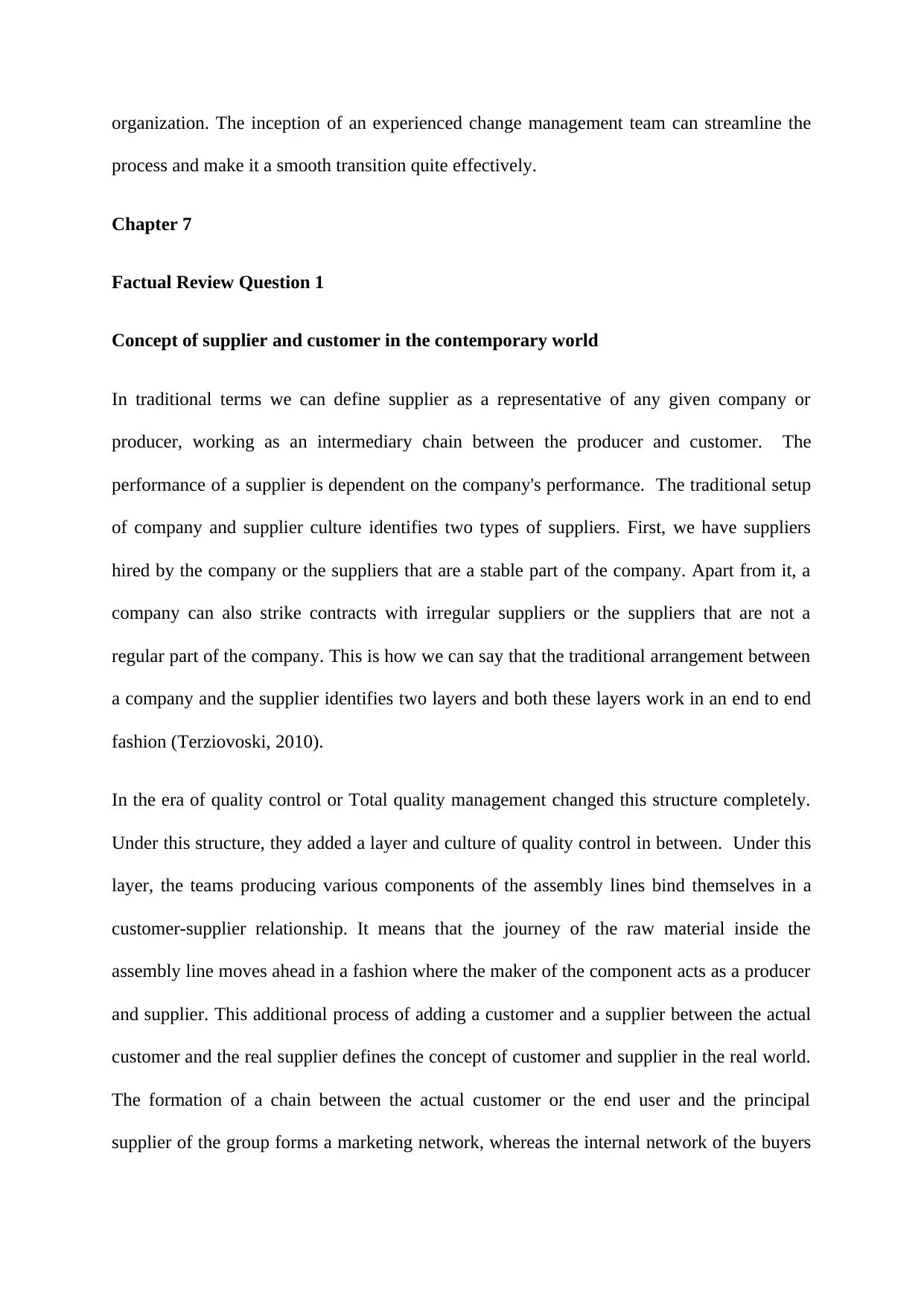
organization. The inception of an experienced change management team can streamline the
process and make it a smooth transition quite effectively.
Chapter 7
Factual Review Question 1
Concept of supplier and customer in the contemporary world
In traditional terms we can define supplier as a representative of any given company or
producer, working as an intermediary chain between the producer and customer. The
performance of a supplier is dependent on the company's performance. The traditional setup
of company and supplier culture identifies two types of suppliers. First, we have suppliers
hired by the company or the suppliers that are a stable part of the company. Apart from it, a
company can also strike contracts with irregular suppliers or the suppliers that are not a
regular part of the company. This is how we can say that the traditional arrangement between
a company and the supplier identifies two layers and both these layers work in an end to end
fashion (Terziovoski, 2010).
In the era of quality control or Total quality management changed this structure completely.
Under this structure, they added a layer and culture of quality control in between. Under this
layer, the teams producing various components of the assembly lines bind themselves in a
customer-supplier relationship. It means that the journey of the raw material inside the
assembly line moves ahead in a fashion where the maker of the component acts as a producer
and supplier. This additional process of adding a customer and a supplier between the actual
customer and the real supplier defines the concept of customer and supplier in the real world.
The formation of a chain between the actual customer or the end user and the principal
supplier of the group forms a marketing network, whereas the internal network of the buyers
process and make it a smooth transition quite effectively.
Chapter 7
Factual Review Question 1
Concept of supplier and customer in the contemporary world
In traditional terms we can define supplier as a representative of any given company or
producer, working as an intermediary chain between the producer and customer. The
performance of a supplier is dependent on the company's performance. The traditional setup
of company and supplier culture identifies two types of suppliers. First, we have suppliers
hired by the company or the suppliers that are a stable part of the company. Apart from it, a
company can also strike contracts with irregular suppliers or the suppliers that are not a
regular part of the company. This is how we can say that the traditional arrangement between
a company and the supplier identifies two layers and both these layers work in an end to end
fashion (Terziovoski, 2010).
In the era of quality control or Total quality management changed this structure completely.
Under this structure, they added a layer and culture of quality control in between. Under this
layer, the teams producing various components of the assembly lines bind themselves in a
customer-supplier relationship. It means that the journey of the raw material inside the
assembly line moves ahead in a fashion where the maker of the component acts as a producer
and supplier. This additional process of adding a customer and a supplier between the actual
customer and the real supplier defines the concept of customer and supplier in the real world.
The formation of a chain between the actual customer or the end user and the principal
supplier of the group forms a marketing network, whereas the internal network of the buyers
⊘ This is a preview!⊘
Do you want full access?
Subscribe today to unlock all pages.

Trusted by 1+ million students worldwide
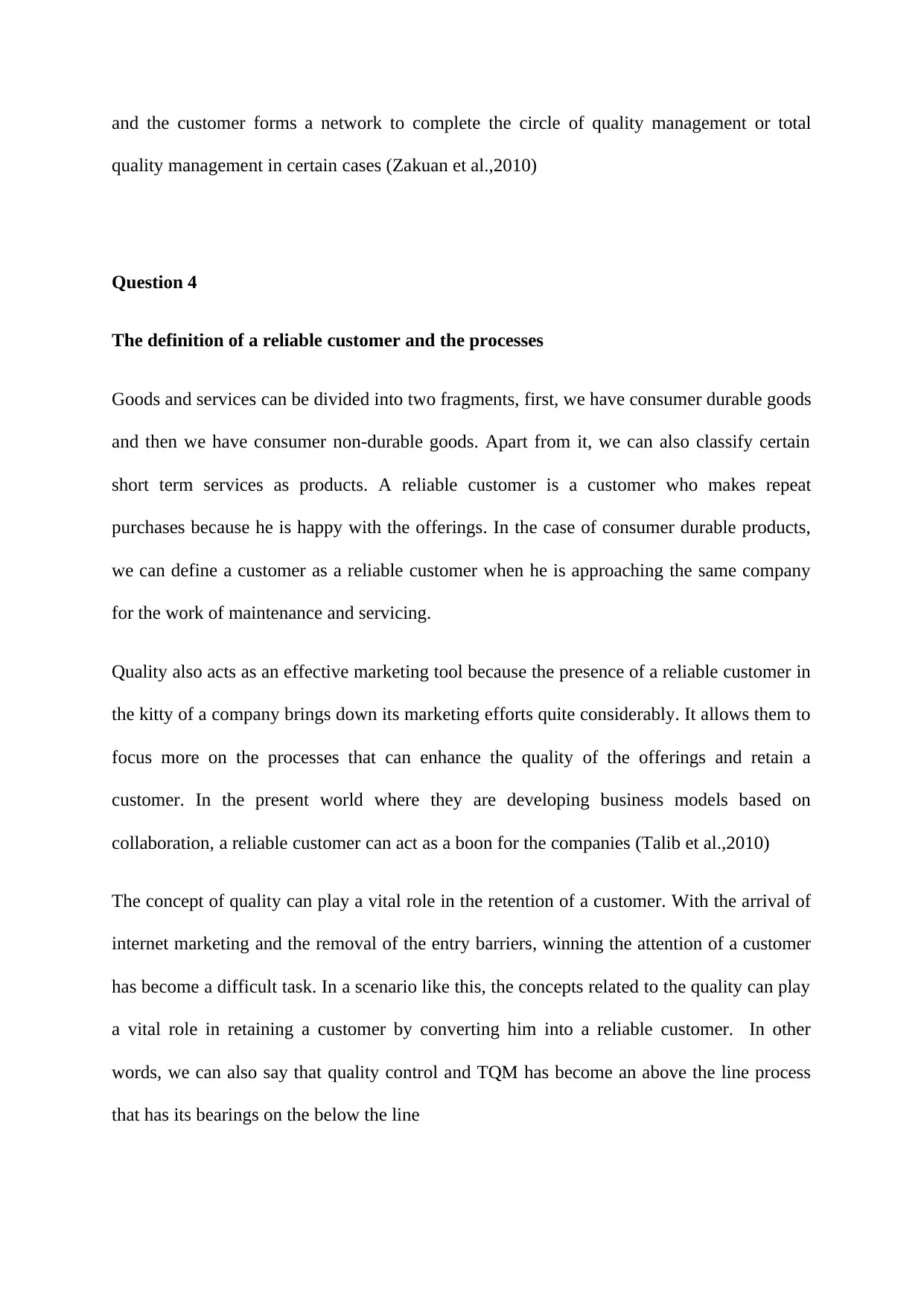
and the customer forms a network to complete the circle of quality management or total
quality management in certain cases (Zakuan et al.,2010)
Question 4
The definition of a reliable customer and the processes
Goods and services can be divided into two fragments, first, we have consumer durable goods
and then we have consumer non-durable goods. Apart from it, we can also classify certain
short term services as products. A reliable customer is a customer who makes repeat
purchases because he is happy with the offerings. In the case of consumer durable products,
we can define a customer as a reliable customer when he is approaching the same company
for the work of maintenance and servicing.
Quality also acts as an effective marketing tool because the presence of a reliable customer in
the kitty of a company brings down its marketing efforts quite considerably. It allows them to
focus more on the processes that can enhance the quality of the offerings and retain a
customer. In the present world where they are developing business models based on
collaboration, a reliable customer can act as a boon for the companies (Talib et al.,2010)
The concept of quality can play a vital role in the retention of a customer. With the arrival of
internet marketing and the removal of the entry barriers, winning the attention of a customer
has become a difficult task. In a scenario like this, the concepts related to the quality can play
a vital role in retaining a customer by converting him into a reliable customer. In other
words, we can also say that quality control and TQM has become an above the line process
that has its bearings on the below the line
quality management in certain cases (Zakuan et al.,2010)
Question 4
The definition of a reliable customer and the processes
Goods and services can be divided into two fragments, first, we have consumer durable goods
and then we have consumer non-durable goods. Apart from it, we can also classify certain
short term services as products. A reliable customer is a customer who makes repeat
purchases because he is happy with the offerings. In the case of consumer durable products,
we can define a customer as a reliable customer when he is approaching the same company
for the work of maintenance and servicing.
Quality also acts as an effective marketing tool because the presence of a reliable customer in
the kitty of a company brings down its marketing efforts quite considerably. It allows them to
focus more on the processes that can enhance the quality of the offerings and retain a
customer. In the present world where they are developing business models based on
collaboration, a reliable customer can act as a boon for the companies (Talib et al.,2010)
The concept of quality can play a vital role in the retention of a customer. With the arrival of
internet marketing and the removal of the entry barriers, winning the attention of a customer
has become a difficult task. In a scenario like this, the concepts related to the quality can play
a vital role in retaining a customer by converting him into a reliable customer. In other
words, we can also say that quality control and TQM has become an above the line process
that has its bearings on the below the line
Paraphrase This Document
Need a fresh take? Get an instant paraphrase of this document with our AI Paraphraser
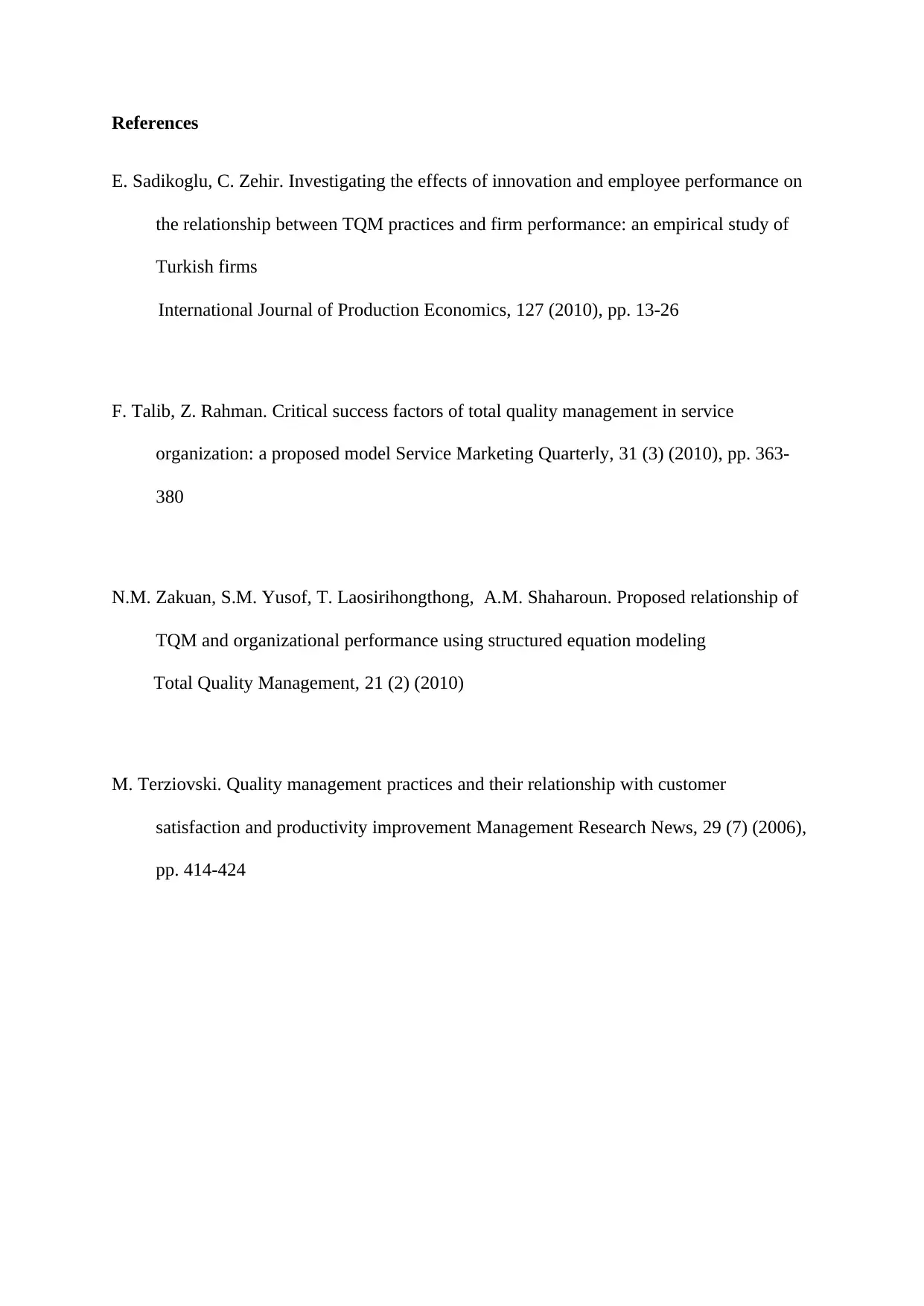
References
E. Sadikoglu, C. Zehir. Investigating the effects of innovation and employee performance on
the relationship between TQM practices and firm performance: an empirical study of
Turkish firms
International Journal of Production Economics, 127 (2010), pp. 13-26
F. Talib, Z. Rahman. Critical success factors of total quality management in service
organization: a proposed model Service Marketing Quarterly, 31 (3) (2010), pp. 363-
380
N.M. Zakuan, S.M. Yusof, T. Laosirihongthong, A.M. Shaharoun. Proposed relationship of
TQM and organizational performance using structured equation modeling
Total Quality Management, 21 (2) (2010)
M. Terziovski. Quality management practices and their relationship with customer
satisfaction and productivity improvement Management Research News, 29 (7) (2006),
pp. 414-424
E. Sadikoglu, C. Zehir. Investigating the effects of innovation and employee performance on
the relationship between TQM practices and firm performance: an empirical study of
Turkish firms
International Journal of Production Economics, 127 (2010), pp. 13-26
F. Talib, Z. Rahman. Critical success factors of total quality management in service
organization: a proposed model Service Marketing Quarterly, 31 (3) (2010), pp. 363-
380
N.M. Zakuan, S.M. Yusof, T. Laosirihongthong, A.M. Shaharoun. Proposed relationship of
TQM and organizational performance using structured equation modeling
Total Quality Management, 21 (2) (2010)
M. Terziovski. Quality management practices and their relationship with customer
satisfaction and productivity improvement Management Research News, 29 (7) (2006),
pp. 414-424
1 out of 5
Your All-in-One AI-Powered Toolkit for Academic Success.
+13062052269
info@desklib.com
Available 24*7 on WhatsApp / Email
![[object Object]](/_next/static/media/star-bottom.7253800d.svg)
Unlock your academic potential
© 2024 | Zucol Services PVT LTD | All rights reserved.

